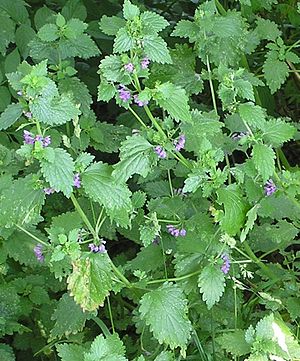Note: This is a project under development. The articles on this wiki are just being initiated and broadly incomplete. You can Help creating new pages.
Difference between revisions of "Ballota nigra - Black horehound"
(→Parts Used) |
(→Parts Used) |
||
| Line 7: | Line 7: | ||
==Parts Used== | ==Parts Used== | ||
| − | {{Parts Used|flower}. | + | {{Parts Used|flower}}. |
==Chemical Composition== | ==Chemical Composition== | ||
Revision as of 18:26, 13 April 2018
Ballota nigra (black horehound) is a perennial herb of the family Lamiaceae. It is native to the Mediterranean region and to central Asia, and it can be found throughout Europe. It is also naturalized in Argentina, New Zealand, and the Eastern United States. It blooms in the Northern Hemisphere from May to August.
Contents
Uses
nervous dyspepsia, travelling sickness, morning sickness in pregnancy, arthritis, gout.
Parts Used
Chemical Composition
Ballota nigra contains diterpenoids like marrubiin, ballonigrin, ballotinone, ballotenol and 7-acetoxymarrubiin. Also, it contains phenylpropanoids that have shown to be antioxidants[1]
Common names
| Language | Common name |
|---|---|
| Kannada | āvarike |
| Hindi | Tarwar |
| Malayalam | |
| Tamil | āvārai |
| Telugu | taṃgēḍu |
| Marathi | NA |
| Gujarathi | NA |
| Punjabi | NA |
| Kashmiri | NA |
| Sanskrit | Aaavartaki |
| English | Avaram senna |
Habit
Identification
Leaf
| Kind | Shape | Feature |
|---|---|---|
| opposite | decussate | range from oval-lanceolate to heart-shaped, with crenate or dentate border. Leaves, dark green and usually pubescent, measure 3–8 cm per 2–6 cm, and have 1–3 cm petiole. Upper face is wrinkled, with a net-like vein patter |
.[2]
Flower
| Type | Size | Color and composition | Stamen | More information |
|---|---|---|---|---|
| bisexual | length 9–10 mm, width 7 mm | purple to withish, pink | Ovary is superior, with a single white style and a 2-parted stigma | Flower has an actinomorphic calyx, made up by five sepals fused together in a tube with five teeths |
Fruit
| Type | Size | Mass | Appearance | Seeds | More information |
|---|---|---|---|---|---|
| cylindrical to ovoid | 2 mm long | Each fertilized flower produces a tetrad of black nutlets | The basal end is flat and attached to the receptacle, while the top end is rounded or pointed. | 12-20 seeds | {{{6}}} |
Other features
List of Ayurvedic medicine in which the herb is used
- Vishatinduka Taila as root juice extract
Where to get the saplings
Mode of Propagation
How to plant/cultivate
Prefers a well-drained soil in full sun or partial shade[3]
Commonly seen growing in areas
Waste ground, hedgerows, shady places, preferring nitrogen-rich, moist
Photo Gallery
References
External Links
- Ayurvedic Herbs known to be helpful to treat nervous dyspepsia
- Ayurvedic Herbs known to be helpful to treat travelling sickness
- Ayurvedic Herbs known to be helpful to treat morning sickness in pregnancy
- Ayurvedic Herbs known to be helpful to treat arthritis
- Ayurvedic Herbs known to be helpful to treat gout
- Herbs with flower used in medicine
- Herbs with common name in Kannada
- Herbs with common name in Hindi
- Herbs with common name in Tamil
- Herbs with common name in Telugu
- Herbs with common name in Sanskrit
- Herbs with common name in English
- Habit - Perennial herb
- Index of Plants which can be propagated by Seeds
- Herbs that are commonly seen in the region of Waste ground
- Herbs that are commonly seen in the region of hedgerows
- Herbs that are commonly seen in the region of shady places
- Herbs that are commonly seen in the region of preferring nitrogen-rich
- Herbs that are commonly seen in the region of moist
- Herbs



